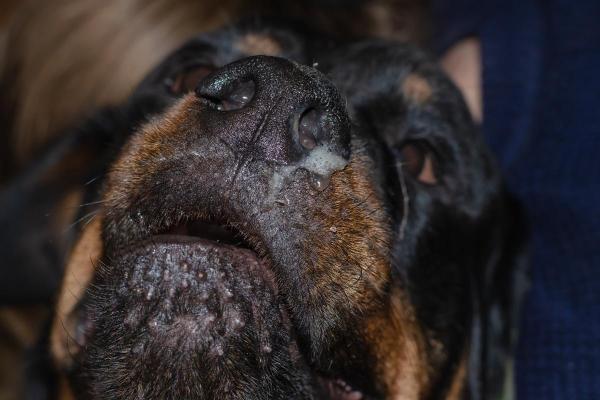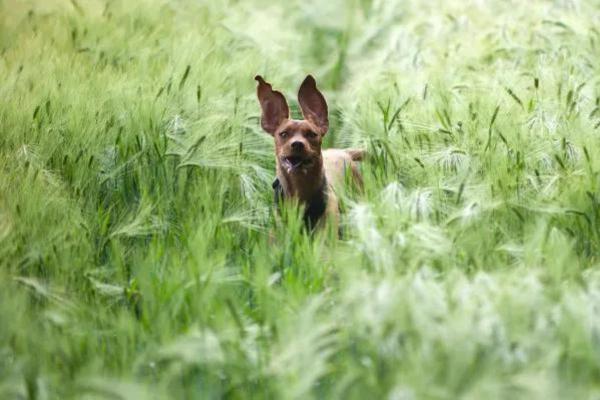
A dog presenting with a runny nose and trouble breathing is a common cause for veterinary consultation. In the majority of cases, the stuffed nose is a result of agitation to the nasal mucosa. The underlying cause of such agitation is varied. They include relatively benign issues such as the common cold, but can also be symptoms of more serious problems, including life-threatening tumors.
AnimalWised investigates why my dog has a stuffed nose and trouble breathing. We understand the causes and treatment for a blocked nose in dogs so we can help them to breathe easily once again.
Causes of a stuffy nose and troubled breathing in dogs
When a dog has as stuffy nose, it is due to problems with the mucosal lining (nasal mucosa). When this mucosa becomes inflamed, it is known as rhinitis. It is not usually because of the inflammation itself that rhinitis occurs. As a concurrent symptom, various types of discharge can block the nasal airways, resulting in a stuffy nose.
A dog's stuffy nose is often runny, but not exclusively. This is usually dependent on the type of nasal secretion, specifically its thickness in the nasal passages. The following are the different types of nasal secretions which can cause a stuffy nose in dogs:
- Serous discharge: transparent and quite thin fluid. It usually appears in mild processes or in the initial stages of infectious disease. As this secretion is thinner, it can run more easily and it may be wet and/or cold to the touch.
- Mucous discharge: it is a thicker discharge and it can have a green or yellowish coloration if there is an infection. Since it is thicker, the dog's nose will be stuffy, but it can also run depending in its viscosity. learn more with our article on why a dog has a runny nose with green mucus.
- Purulent discharge: it is a whitish and viscous discharge, which is associated with the existence of a bacterial infection.
- Bloody discharge: when the discharge appears tinged with red due to bleeding in the nasal mucosa.
In dogs with rhinitis, we often see they have a stuffy nose and trouble breathing. The reason is because the agitation to the nasal cavity and the accumulated secretions block the airways. When it affects the upper respiratory tract, it can make the nose stuffy and provide trouble breathing. When the infection or other problem spreads, it can make the dog's breathing even more difficult.
Bronchitis or pneumonia
Bronchitis is the term used to refer to inflammation of the bronchi in the dog's lungs. When we refer to a chest cold, we are usually referring to acute bronchitis. Pneumonia is another type of inflammatory lung condition, this time affecting the alveoli.
These are types of lower respiratory infections which do not necessarily mean the dog will have a stuffy nose, but they will cause trouble breathing. If the infection spreads or is concurrent with an upper respiratory disease, then we may see a blocked nose.
Another reason we don't always see as stuffy nose is because the secretions from the lungs rise to the pharynx and are swallowed. Instead of going to other parts of the respiratory tract, they enter the digestive tract via the esophagus. While we know the general reasons why a dog has a stuffy nose and trouble breathing, we look into these causes in more detail with the sections below.
Infectious rhinitis
There are different infectious agents capable of causing rhinitis in dogs. Depending on the pathological agent, infectious rhinitis can be classified into three groups:
- Viral rhinitis: caused by viruses such as canine distemper. In these cases, a fairly transparent nasal discharge usually occurs, accompanied by other symptoms such as conjunctivitis and ocular discharge.
- Bacterial rhinitis: caused by bacteria such as Bordetella, Streptococcus, or Staphylococcus. These bacteria generally tend to cause infections secondary to other processes, such as viral infections, foreign bodies, oronasal fistulas, etc. In these cases, it is common to find a mucopurulent, white or yellow discharge.
- Fungal or fungal rhinitis: caused by fungi such as Aspergillus or Penicillium. They are usually very aggressive forms of rhinitis, which cause destruction of the nasal mucosa and even the anatomy of the nose itself (nasal turbinates, nasal septum and orbit). These types of rhinitis usually produce a mucopurulent nasal discharge which can also include blood from the dog's nose and is accompanied by nasal pain (due to tissue destruction).
To diagnose the type of rhinitis, it is necessary to take nasal samples and perform cultures to determine the causative agent of infection. Once this has been determined, a specific antimicrobial therapy should be established. This requires antibiotics, antivirals or antifungals, depending on the case. In addition, it may be useful to administer drugs that help expel mucus (such as mucolytics or expectorants) and place humidifiers to fluidize secretions and promote their expulsion.

Irritant rhinitis
Veterinarians often see dogs with stuffy noses which are retching. There are various reason for this problem, but one of the most common is irritant rhinitis.
A dog's nasal passage functions in such a way that it should expel anything which shouldn't be there. The reason a dog has a runny nose is because the nasal mucosa is trying to remove pathogens or other agents. In the case or irritant rhinitis, the agent is a substance which is more actively irritating the nose. These irritants take various forms, including:
- Dust
- Smoke
- Pollution
- Caustic vapors
- Chemicals
Chemicals are a common irritant for dogs as they are used for various purposes in the home. Cleaning agents, disinfectants, varnishes and other products can cause irritation to the dog. The severity of the irritation usually depends on the level of exposure. The irritation is a result of the dog's body activating defense mechanisms to protect itself. These mechanisms include:
- Nasal discharge (usually serous, transparent and fluid)
- Sneezing
- Retching
To prevent the appearance of this type of rhinitis, it is important to prevent exposure to irritants in the first place. In the event an exposure has already occurred, an attempt to decontaminate the nasal passages may be performed by flushing it with saline solution. This needs to be done by a professional as there is a risk of aspiration.
Foreign bodies
The entry of foreign bodies into the nasal cavity is a very common cause of rhinitis. We distinguish between these and irritative substances because foreign bodies are larger. One of the most common is foxtails, a very sharp seed casing which has barbs. This can become lodged in the dog's nose and result in severe rhinitis.
Other elements such as sticks, stones, toys, coins or anything small enough to fit inside can become foreign bodies. In these cases, the discharge begins as serous, but over time it begins to become serosanguinous (appearance of blood), mucoid or purulent, the latter occurring if complicated by a bacterial infection.
Treatment requires the removal of the foreign body by rhinoscopy (looking at the nasal passge with a special camera). The establishment of antibiotic therapy in the event of associated bacterial infections will also likely be required.

Dental problems
Sometimes dental problems can move to the nasal cavity and cause a stuffed nose in dogs. In dogs suffering from advanced periodontal disease, abscesses can form at the root of the teeth. Over time, this can lead to the development of an oronasal fistula (i.e. a passage between the oral and nasal cavities). Through the fistulas, the infection can be transmitted to the nasal cavity, generating rhinitis.
In these cases, canine periodontal disease should be treated primarily (usually by extracting the affected teeth). In addition, it is important to establish a systemic antibiotic treatment to treat the infection. If the infection spreads sufficiently,. it can become systematic and even produce trouble breathing.
Tumors
Another cause that can trigger the appearance of rhinitis in dogs are neoplasms, both benign and malignant:
- Benign neoplasms: such as polyps.
- Malignant neoplasms: such as adenocarcinoma , fibrosarcoma, chondrosarcoma, osteosarcoma or squamous cell carcinoma in dogs.
In addition to nasal discharge, it is common for the dog to present respiratory distress (due to obstruction of the airways) and deformations of the nasal plane. With the passage of time, the clinical signs usually worsen, leading to bloody discharge and increasingly marked respiratory distress.
Treatment of these tumors requires surgical removal. This is usually combined with other therapies such as radiation therapy or chemotherapy for dogs. It should be noted that nasal tumors are among the neoplasms that best respond to radiotherapy. However, the high cost of this treatment and the small number of centers that offer it make it a treatment option that is often difficult to access.

Allergies
Allergic rhinitis can occur, although it is rare. They are generally seasonal problems, which appear associated with pollen or certain plant fibers. Dust mites, mold and other microorganisms can also act as allergens. In these cases, there is usually a serous nasal discharge (transparent and quite fluid), which is accompanied by other signs such as sneezing, coughing or general trouble breathing.
As their guardians, it is important to prevent dogs from coming into contact with allergens. In the event that clinical signs appear, it may be necessary to start a treatment with corticosteroids or consider an immunotherapy treatment. The latter may include autovaccines specifically designed for each patient.
As you have seen, the reasons why a dog has a stuffy nose and trouble breathing are varied. Whenever you detect the appearance of this clinical sign in your dog, either alone or accompanied by other symptoms, it is advisable you go to a trusted veterinarian. They can determine the cause of the process and establish the most appropriate treatment in each case.
Learn more about the treatment of canine allergies by reading our guide to the allergy medications safe for dogs.
This article is purely informative. AnimalWised does not have the authority to prescribe any veterinary treatment or create a diagnosis. We invite you to take your pet to the veterinarian if they are suffering from any condition or pain.
If you want to read similar articles to My Dog Has a Stuffy Nose and Trouble Breathing, we recommend you visit our Breathing diseases category.